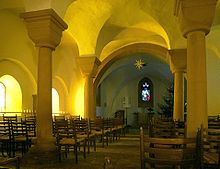Munster St. Boniface
The St. Boniface Minster is a former Evangelical Lutheran monastery and collegiate church in Hameln . It is located on the southwest edge of the historic old town not far from the Weser . The church is an element of the city arms of Hamelin.
construction
Today's building clearly shows the traces of its eventful history. Romanisch are the north-south cross-house with the octagonal central tower and the transverse rectangular West Tower, gothic that the church hall converted dreischiffige nave , the final flat choral and Elisabeth Chapel on the southern transept. The crossing tower received its lantern in the baroque era . Neo-Romanesque forms show, especially on the north side of the church, but also on the towers, components that go back to the renovation under Conrad Wilhelm Hase 1870–75. Most of the interior is from the late 20th century.
history
The oldest part, dating back to the time the church was founded, is the crypt . It marks the nucleus of the minster: an own church that the Saxon couple Bernhard and Christina von Engern and Ohsen had built soon after 800. When both died in 826 with no descendants, their property fell to the Benedictine imperial abbey of Fulda , which established a secondary monastery here, which they furnished with relics of their founder Bonifatius . In 851 the bones of St. Romanus of Caesarea added, so that the monastery and the church bore the patronage of both saints until the 13th century when the name St. Boniface became established.
Probably in the 11th century the monastery was converted into a collegiate monastery, under whose jurisdiction the market settlement of Hameln developed. The Romanesque cross basilica was created. In 1259, after a fire and renovation of the cathedral church, Fulda sold its Hamelin property to the Duchy of Minden . In the following century, extensive renovation work was carried out on the church, which led to its current Gothic appearance.
The Reformation , which took place in the market church of St. Nikolai in 1540, did not take place in the monastery until 1578. Most of the medieval furnishings have now been removed. However, the monastery continued to exist as a Protestant body until 1848.
In 1760 the cloister had to give way to a facility in the Hameln Fortress . The church began to deteriorate and was eventually abandoned as a place of worship. In the early 19th century it was used as a stable and warehouse.
Mainly through the tireless efforts of Franz GF Schläger, the will to restore the minster finally prevailed. In 1875 it could be inaugurated again. A hundred years later, another thorough renovation was carried out in which the neo-Romanesque furnishings were replaced by contemporary pieces.
organ
The organ of the cathedral church was built in 1980 by the organ building company Marcussen & Søn (Appenrade, Denmark). The instrument has 28 registers on slider drawers . The actions are mechanical.
|
|
|
|
|||||||||||||||||||||||||||||||||||||||||||||||||||||||||||||||||||||||||||||||||||||||||||||||||
- Coupling : I / II, III / II, I / P, II / P, III / P
Bells
From the 18th century, four bronze bells hung in the west tower. The largest bell was expropriated for army purposes in 1917. After the First World War, three steel bells of the Bochum Association for Mining and Cast Steel Manufacture (Bochum) were hung in the tower in 1921. The three remaining bronze bells are no longer part of the peal; two of the bells serve as clock chimes and hang outside on the east side of the west tower; the oldest bell, the so-called Warmbiers bell, hangs at the crypt entrance.
| No. |
Surname |
Casting year |
Caster |
Diameter (cm) |
Weight (kg) |
Nominal |
Inscription, notes |
|---|---|---|---|---|---|---|---|
| 1 | 1921 | Bochum Association | 177 | 4,500 | h 0 | Contr. v. Bochum Association i. Bochum 1920. In memory of their sons Fritz † 1916 and Karl † 1917, who died in the World War [donated by] Heinrich Meyer-Hermann and Mrs. Marie born. Otto. You coming, be united, loyal and strong in faith! | |
| 2 | 140 | 2,700 | d 1 | O land, land, hear the word of the Lord (Jeremiah 22:29) | |||
| 3 | 133 | 2,200 | f 1 | In difficult times I gave bronze for steel. | |||
| I. | Boniface | 1663 | Georg Denner | about 600 | c sharp 2 |
Georg Denner me fecit anno 1663 in Hameln (picture of St. Boniface) bell that strikes 15 minutes |
|
| II | Osanna silver bell |
1466 | 71.5 | 800 | it 2 |
Osanna bin eck called anno Domini 1466 chime bell, also called "silver bell" |
|
| III | Warmbiers bell | 1451 | Hartmann | 73.5 | 400 | c 2 |
anno domini 1451 15 the decembris Hartmannus me fecit. jesus christ mary st. bonifacius The bell was only rung at public funerals. The origin of the name is not known. Perhaps "Warmbier" was the name of the foundry workshop, but it may also go back to the custom that warm beer was drunk after funerals. |
literature
- Wolfgang Erdmann, Ernst Oppermann, Petra Rabbe-Hartinger: The Minster of Hameln. Langewiesche, Königstein im Taunus 2002, ISBN 978-3-7845-0655-5 .
- Ev. Munster St. Boniface. In: Georg Dehio : Handbook of German Art Monuments . Bremen Lower Saxony. Deutscher Kunstverlag, Munich / Berlin 1992, pp. 587–590; ISBN 3-422-03022-0
Web links
Individual evidence
- ↑ More about the Marcussen organ
- ↑ Information about the bells (as of December 5, 2018)
Coordinates: 52 ° 6 ′ 6 ″ N , 9 ° 21 ′ 16.3 ″ E





